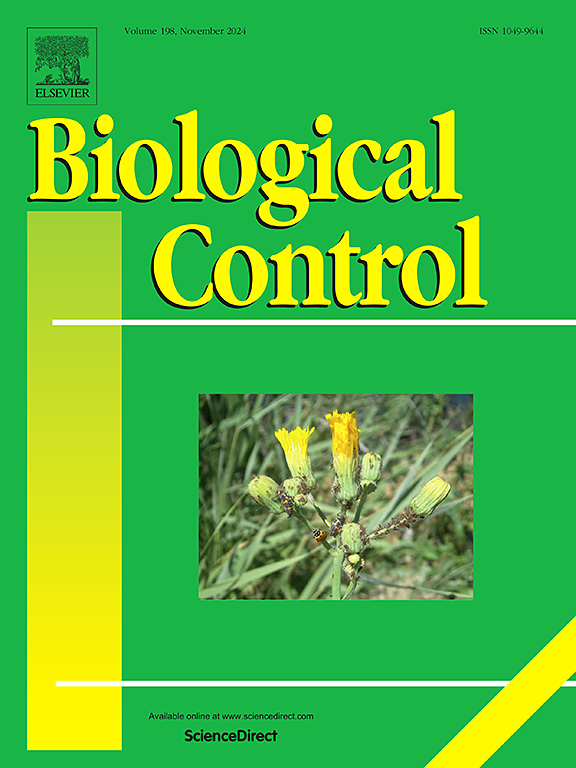一种方法不适合所有人:跨大洲的传统杂草生物控制
IF 3.7
2区 农林科学
Q2 BIOTECHNOLOGY & APPLIED MICROBIOLOGY
引用次数: 0
摘要
杂草生物防治剂的放行前检疫测试通常采用简单的无选择测试。然而,这些基本的寄主范围测试是保守的,通常不能真实地描述潜在的生物防治剂如何与田间周围的非目标植物相互作用。如果无选择试验是采用的唯一方法,则可能导致对充分的宿主特异性药物的排斥。在生物防治剂原生或已经存在的地区进行生态寄主范围研究,可以测试实验室研究结果的有效性,并具有评估昆虫远程寄主识别行为的优势。2019年,在美国佛罗里达州,一项针对拟蓟马(Schinus terebinthifolia Raddi)的杂草生物防治项目获准释放拟蓟马(Pseudophilothrips ichini)(飞虱目:拟蓟马科)。来自美国项目的信息为其他有巴西胡椒树入侵的国家提供了见解,例如澳大利亚,它在阿纳卡迪科家族中有几个本地非目标物种。为了评估ichini对三种澳大利亚本地非目标物种(Rhus taitensis, Pleiogynium timoriense和Euroschinus falcatus)的非目标攻击风险,我们进行了两阶段的露天实验,模拟生物防治剂在其首选寄主S. terebinthifolia存在和不存在的情况下的溢出风险。在野外试验中还包括美国和澳大利亚引进的S. terebinthifolia的近亲Schinus molle和夏威夷本土的rus sandwich。结果表明,在没有目标杂草S. terebinthifolia的情况下,ichini种群可能会溢出到两种非目标植物S. molle和R. taitensis上,并可能对澳大利亚本土物种S. terebinthifolia构成威胁。这项工作强调了入侵植物生物防治项目国际合作的重要性。本文章由计算机程序翻译,如有差异,请以英文原文为准。

One size does not fit all: Classical weed biological control across continents
Pre-release quarantine testing of weed biological control agents is frequently initiated using simple no-choice tests. However, these fundamental host range tests are conservative and often do not realistically depict how potential biological control agents might interact with surrounding non-target plants in the field. If no-choice tests are the only method employed it can lead to the rejection of sufficiently host-specific agents. Ecological host range studies in areas where the biological control agent is native or already present can test the validity of laboratory findings with the advantage of evaluating long-range host-recognition behaviors of the insect. A weed biological control program targeting Schinus terebinthifolia Raddi (Anacardiaceae) was given permission to release Pseudophilothrips ichini (Hood) (Thysanoptera: Phlaeothripidae) in Florida, USA in 2019. Information from the program in the USA has provided insight for other countries with invasive Brazilian peppertree, such as Australia, which has several native non-target species within the Anacardiaceae family. To evaluate the risk of non-target attack by P. ichini on three Australian native non-target species (Rhus taitensis, Pleiogynium timoriense, and Euroschinus falcatus), we performed a two-phase open-field experiment to simulate the spillover risk of the biological control agent in both the presence and absence of their preferred host, S. terebinthifolia. Also included in the open-field experiment were Schinus molle, a close relative of S. terebinthifolia introduced in the USA and Australia, and the Hawaii native Rhus sandwicensis. The results suggest that P. ichini populations may spill over onto two non-target plants, S. molle and R. taitensis, in the absence of the target weed S. terebinthifolia, and could pose a risk to this native species in Australia. This work highlights the importance of international collaborations on invasive plant biocontrol programs.
求助全文
通过发布文献求助,成功后即可免费获取论文全文。
去求助
来源期刊

Biological Control
生物-昆虫学
CiteScore
7.40
自引率
7.10%
发文量
220
审稿时长
63 days
期刊介绍:
Biological control is an environmentally sound and effective means of reducing or mitigating pests and pest effects through the use of natural enemies. The aim of Biological Control is to promote this science and technology through publication of original research articles and reviews of research and theory. The journal devotes a section to reports on biotechnologies dealing with the elucidation and use of genes or gene products for the enhancement of biological control agents.
The journal encompasses biological control of viral, microbial, nematode, insect, mite, weed, and vertebrate pests in agriculture, aquatic, forest, natural resource, stored product, and urban environments. Biological control of arthropod pests of human and domestic animals is also included. Ecological, molecular, and biotechnological approaches to the understanding of biological control are welcome.
 求助内容:
求助内容: 应助结果提醒方式:
应助结果提醒方式:


